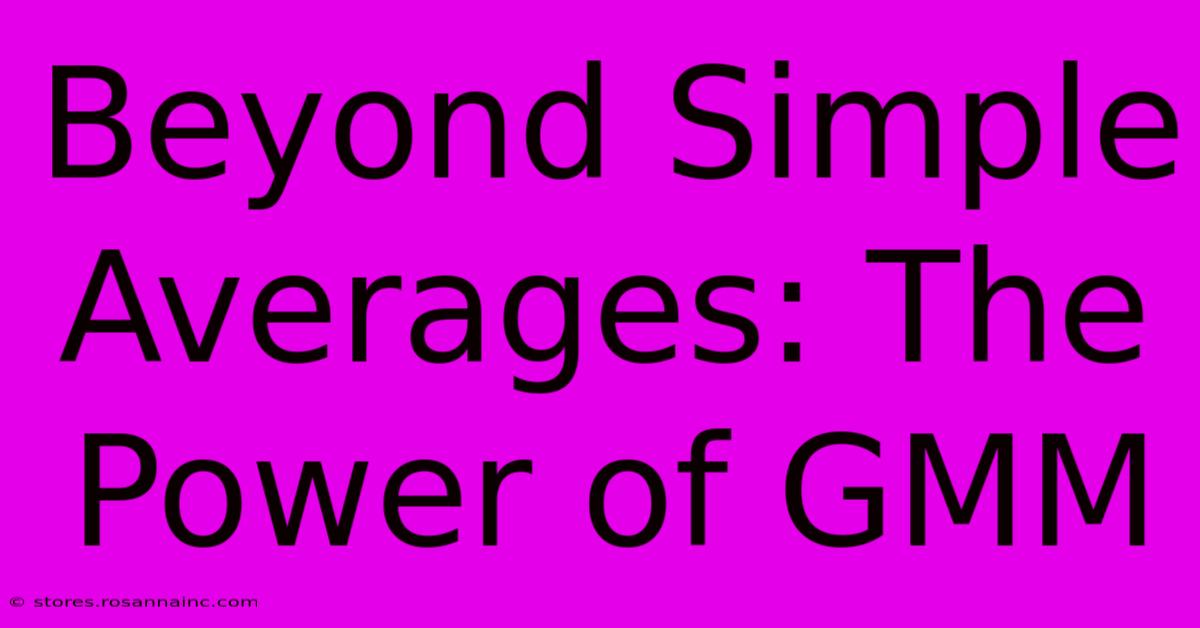Beyond Simple Averages: The Power Of GMM

Table of Contents
Beyond Simple Averages: The Power of Gaussian Mixture Models (GMM)
Simple averages, while useful for quick summaries, often fail to capture the complexity inherent in many datasets. Real-world data rarely follows a neat, single distribution. This is where Gaussian Mixture Models (GMMs) shine. GMMs offer a powerful way to uncover hidden structure and gain deeper insights from data that's far from uniform. This article delves into the capabilities of GMMs, exploring their applications and showcasing their advantages over simpler approaches.
Understanding Gaussian Mixture Models
At its core, a GMM assumes that your data is generated from a mixture of several Gaussian distributions (also known as normal distributions). Each Gaussian component has its own mean and covariance, representing a distinct cluster or subgroup within your data. The model learns the parameters of these Gaussian components – their means, covariances, and the weight (or proportion) of each component in the mixture – to best fit your data. This means GMMs can effectively model data exhibiting multiple clusters, even when those clusters overlap.
Key Advantages of GMMs:
- Modeling Complex Distributions: Unlike simple averages that assume a single distribution, GMMs handle multi-modal data gracefully. This is crucial when dealing with datasets showing distinct subgroups or clusters.
- Clustering and Segmentation: GMMs are widely used for unsupervised clustering. They group data points based on their probability of belonging to a specific Gaussian component, revealing underlying patterns and segments.
- Density Estimation: GMMs provide a probability density function (PDF) that estimates the likelihood of observing data points within a given range. This is particularly valuable for understanding data distribution and identifying outliers.
- Flexibility and Extensibility: GMMs offer flexibility through parameters that control the complexity of the model. You can adjust the number of Gaussian components to match the inherent structure of your data. Moreover, various extensions and modifications of the basic GMM framework cater to specific data characteristics.
GMM Applications: Where it Truly Shines
GMMs have found widespread application across diverse fields. Here are just a few examples:
- Image Segmentation: GMMs can segment images by grouping pixels with similar color characteristics into distinct regions, facilitating object recognition and image analysis.
- Customer Segmentation: In marketing, GMMs can cluster customers based on their purchasing behavior, demographics, or preferences, enabling targeted advertising and personalized recommendations.
- Financial Modeling: GMMs can model the distribution of asset returns, capturing the potential for different market regimes or risk levels.
- Speech Recognition: GMMs play a crucial role in acoustic modeling, helping to identify and classify different sounds in speech signals.
- Anomaly Detection: By modeling the normal data distribution with a GMM, deviations from this distribution can be identified as anomalies or outliers.
GMM vs. Simple Averages: A Clear Distinction
The key difference lies in the assumptions each method makes about the data. Simple averages assume a single, uniform distribution, which is often unrealistic. GMMs, on the other hand, explicitly model the presence of multiple distributions, offering a far more nuanced and accurate representation of complex datasets. Consider a dataset representing customer income: a simple average might mask the presence of high-income and low-income groups. A GMM, however, would identify these distinct clusters, providing far more valuable insights.
Implementing GMMs: Tools and Techniques
Many statistical software packages and programming languages offer robust implementations of GMM algorithms. Popular choices include:
- Scikit-learn (Python): Provides a user-friendly implementation with various options for parameter tuning.
- MATLAB: Offers built-in functions for GMM fitting and analysis.
- R: Packages like
mclustprovide extensive capabilities for GMM-based clustering and model selection.
Choosing the right tool depends on your familiarity with different programming languages and the specific requirements of your analysis. Effective implementation often requires careful consideration of the number of Gaussian components and other model parameters to achieve optimal results.
Conclusion: Unlocking the Potential of Your Data
Gaussian Mixture Models provide a sophisticated tool for analyzing complex datasets that go beyond the limitations of simple averages. By uncovering hidden structures and modeling multiple distributions, GMMs offer valuable insights in diverse fields, from image processing to financial modeling. Their flexibility and power make them an invaluable asset for data scientists and analysts seeking to extract deeper understanding from their data. Understanding and utilizing GMMs is a crucial step in moving beyond superficial data analysis and towards a more comprehensive and insightful understanding of the world around us.

Thank you for visiting our website wich cover about Beyond Simple Averages: The Power Of GMM. We hope the information provided has been useful to you. Feel free to contact us if you have any questions or need further assistance. See you next time and dont miss to bookmark.
Featured Posts
-
The Wire Season 4 Explained Everything You Need To Know
Feb 10, 2025
-
From Trauma To Triumph The Cleveland Elementary Story
Feb 10, 2025
-
Lennox Lewis Vs Mike Tyson Who Really Won
Feb 10, 2025
-
Control The Chaos Mastering Avatar Fire And Ash
Feb 10, 2025
-
Smith Makes Super Bowl Lix History
Feb 10, 2025
